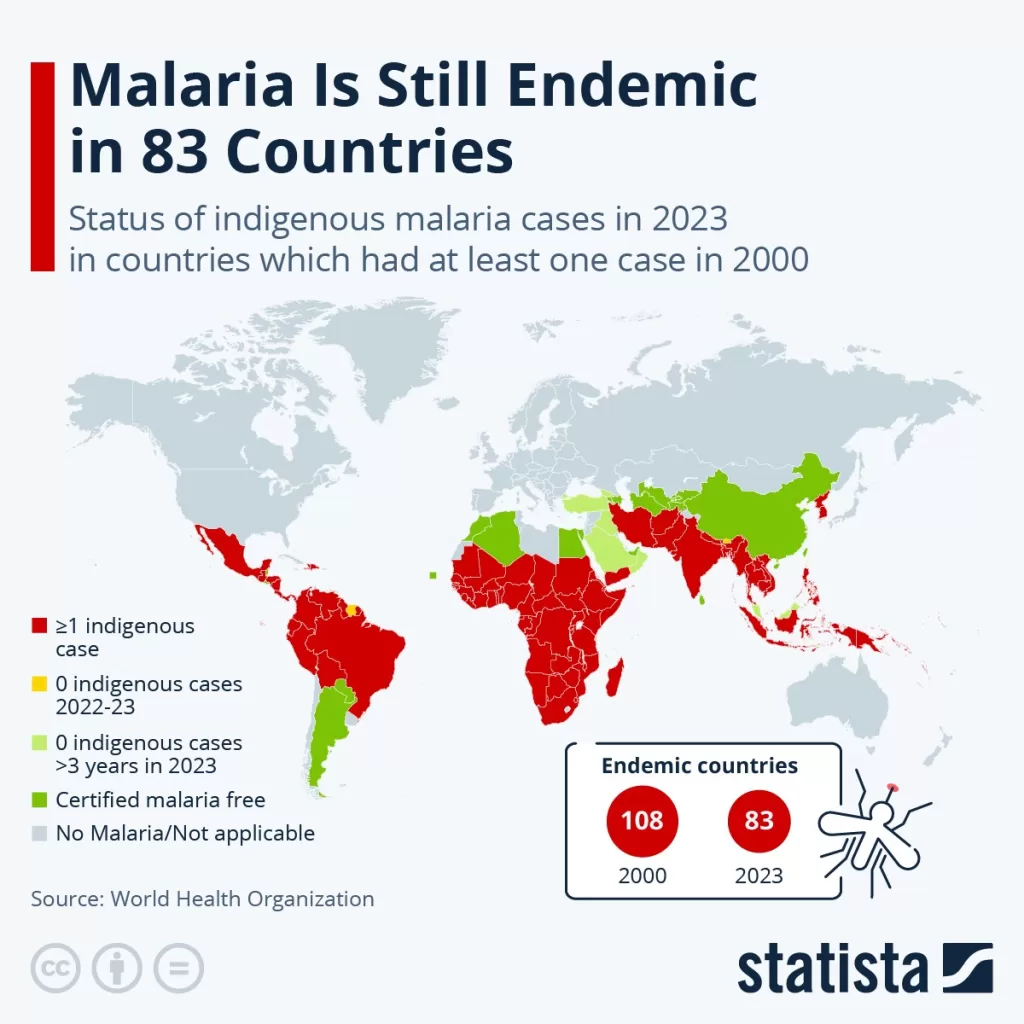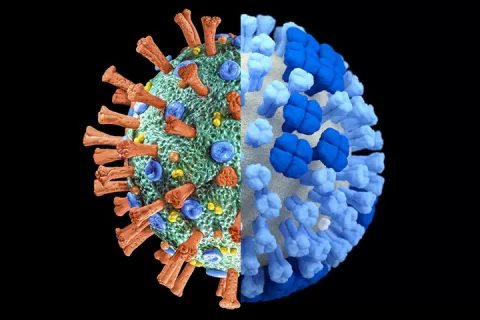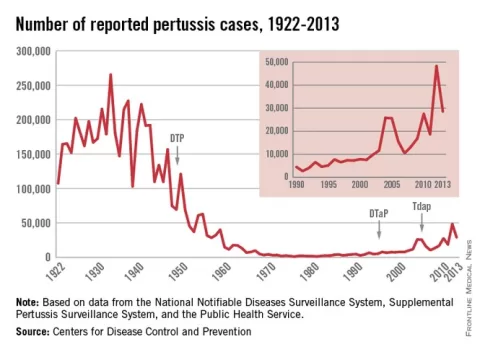In 2023, the number of malaria cases surged significantly, with recent data revealing an alarming increase that has grabbed the attention of global health organizations. According to the World Health Organization’s malaria report, there were 11 million more cases reported this year compared to the previous year, highlighting the persistent challenge of malaria, particularly in Africa, where malaria deaths account for a staggering 95% of the global total. The WHO malaria report also indicates that approximately 263 million cases of malaria and 597,000 fatalities occurred worldwide in 2023, underscoring the urgent need for sustained malaria control efforts. Despite these numbers, there are signs of progress, including the introduction of malaria vaccinations in several regions. As experts and health officials analyze malaria statistics for 2023, it becomes clear that while advancements are being made, much work remains to be done to combat this deadly disease.
The surge in malaria incidences in 2023 indicates a troubling trend in one of the world’s most dangerous diseases. In specifically targeted regions, especially within Africa, more individuals are suffering from this parasitic illness, sparking renewed discussions about public health strategies. The alarming figures reported denote an increase in cases and fatalities, prompting the global health community to reassess their approaches to effective treatment and vaccination. Comprehensive malaria control measures, crucial for reducing transmission and improving health outcomes, are being prioritized. As the new data unfolds, the focus shifts not only to managing current cases but also to preventing future outbreaks and strengthening immunization efforts.
Overview of Malaria Cases in 2023
The World Health Organization (WHO) presented alarming findings in its latest report, revealing that malaria cases surged significantly in 2023, increasing by 11 million when compared to the previous year. This uptick underscores the persistent struggle against this lethal disease, which continues to claim lives globally. With an estimated 263 million cases reported, the threat of malaria has not dissipated, despite the ongoing global efforts aimed at prevention and treatment. Understanding the underlying factors contributing to this increase is critical for public health officials and policymakers.
In the African region, which accounts for a staggering 95% of malaria fatalities, the impact of this disease is felt most acutely. Despite the total number of malaria deaths in Africa remaining stable at approximately 597,000, the sheer volume of cases and the resultant mortality rates highlight the ongoing need for focused interventions. The rise in malaria cases points to challenges in control measures and emphasizes the importance of ongoing funding and resources to combat this public health crisis.
Malaria Statistics and Control Efforts
The 2023 malaria statistics have drawn significant attention from health experts and organizations worldwide. With 11 million additional cases reported in just one year, the global community is prompted to reevaluate its malaria control strategies. The WHO report emphasizes that while some regions have made progress, substantial work remains to be done. Many countries have initiated malaria control efforts, benefiting from newer technologies, such as insecticide-treated nets and rapid diagnostic tests, which have optimized prevention efforts.
Despite these advancements, the report reveals that countries with high burdens of malaria must increase their commitment to ongoing control measures. This includes a focus on funding for malaria research and the implementation of effective vaccination programs. Moreover, the disparity in malaria cases among countries indicates that coordination and collaboration between nations are crucial to achieving a malaria-free future.
Malaria Deaths and Mortality Rates in Africa
Malaria remains one of the leading causes of mortality on the African continent, where 11 nations account for about 70% of all malaria cases globally. The mortality rate, although showing a 15% reduction since 2015, still presents a stark reality with 52.4 deaths per 100,000 population, exceeding the WHO’s target of 23 deaths per 100,000. This highlights the severity of the malaria burden, particularly in vulnerable groups such as young children and pregnant women, who bear the highest risk of severe outcomes.
Efforts to address malaria deaths in Africa are essential in driving down mortality rates. The focus remains on identifying hotspots and implementing targeted interventions, including health education, access to preventative measures, and effective treatment protocols. With renewed commitments from health ministers within affected countries, there is potential for a more robust response to the malaria crisis, ultimately aiming to reduce the toll it takes on communities.
Malaria Vaccination Initiatives
The introduction of malaria vaccines has marked a significant milestone in the fight against this disease, especially in sub-Saharan Africa, where the burden is heaviest. In 2023, 17 countries have successfully integrated malaria vaccines into their routine childhood immunization schedules. These efforts reflect a growing recognition of the importance of immunization strategies as a part of comprehensive malaria control frameworks aimed at reducing incidence rates and enhancing community protection.
With promising data emerging from clinical trials for malaria vaccines, health organizations are urged to prioritize widespread distribution and accessibility of these life-saving interventions. Vaccination campaigns must be coupled with public awareness initiatives to ensure communities understand the benefits of immunization in preventing malaria. This combined approach not only strengthens immunity in at-risk populations but also complements existing malaria control efforts aimed at scaling back the prevalence of the disease.
Global Response to Malaria Control Efforts
The increasing incidence of malaria cases has sparked a renewed global response to control efforts, with a particular focus on collaborative initiatives and investment in preventive measures. The World Health Organization and other global health entities are calling for additional funding and resources to enhance malaria control strategies in endemic regions. Maintaining and expanding efforts such as the distribution of insecticide-treated nets and access to effective treatments remains essential as part of a multi-faceted approach against malaria.
Moreover, collaboration among nations is critical for sharing best practices and innovations in malaria control. Countries that have successfully reduced their malaria burden serve as models for others struggling with high incidence rates. Global partnerships, community engagement, and investment in research are pivotal in achieving long-term success in malaria eradication goals, as emphasized by the WHO’s ongoing resolve to address the malaria epidemic through united efforts.
The Role of WHO in Malaria Programmes
The World Health Organization plays a central role in coordinating global efforts to combat malaria. Their annual reports provide crucial insights into data trends, informing public health policies and strategies worldwide. Through initiatives like the Global Fund and Roll Back Malaria, the WHO emphasizes not only the importance of prevention and treatment but also of research in creating effective interventions against this preventable disease.
Furthermore, the WHO’s certification of malaria-free countries highlights the potential for success in malaria eradication efforts. Currently, 44 countries and one territory have achieved this status, reflecting effective control measures and collaborative health systems. This demonstrates that with sustained effort and international cooperation, other countries can also achieve similar milestones as the global community works to eliminate malaria.
Community Engagement in Malaria Prevention
Community engagement is critical to the success of malaria prevention and control initiatives. Health education campaigns that inform communities about prevention tactics, such as the use of mosquito nets and insect repellents, can empower individuals to take proactive measures against malaria. Additionally, involving local leaders and community health workers in outreach efforts can foster trust and ensure that accurate information is disseminated effectively.
Moreover, equipping communities with the tools they need to combat malaria—such as rapid tests and treatments—enables quicker responses to suspected cases. By combining education with access to resources, communities are better positioned to reduce malaria transmission rates and protect the most vulnerable populations, thus playing an important role in the overall fight against malaria.
Innovations in Malaria Treatment
Innovations in malaria treatment have significantly progressed in recent years, incorporating new technologies and methodologies aimed at improving outcomes for affected individuals. The introduction of rapid diagnostic tests and artemisinin-based combination therapies (ACTs) has revolutionized treatment practices, allowing for quick diagnosis and effective treatment of malaria infections. These advancements are crucial, especially in areas where malaria is endemic.
Additionally, the development of longer-lasting insecticide-treated nets and new vector control strategies has undergone research and field trials. These innovative approaches are essential for complementing treatment solutions and ultimately reducing malaria transmission rates. By embracing modern technology and continually adapting treatment protocols, researchers and health systems can enhance the effectiveness of malaria control efforts.
Future Directions in Malaria Eradication Efforts
Looking ahead, the future of malaria eradication depends on a multifaceted approach that combines existing strategies with innovative practices. The WHO and global health organizations are encouraged to prioritize funding for research and development of new vaccines, treatments, and technologies that can further reduce malaria incidence and mortality. The sustainable integration of these innovations into public health systems is vital for long-term success.
Additionally, maintaining strong cross-border collaborations and community involvement will be necessary to address the complexities of malaria transmission. Stakeholders must work together to ensure that control measures are adapted to local contexts, resulting in custom-tailored interventions that effectively target transmission dynamics. As the fight against malaria continues, the collective goal of achieving a malaria-free world must remain at the forefront of global health initiatives.
Frequently Asked Questions
What are the Malaria statistics 2023 according to the WHO report?
The WHO report for 2023 indicates a total of 263 million malaria cases globally, marking an increase of 11 million cases compared to 2022. Despite this rise, mortality rates remain similar, with approximately 597,000 malaria deaths recorded, predominantly in the African region.
What factors contributed to the rise in malaria cases 2023?
The rise in malaria cases in 2023 can be attributed to several factors including increased transmission in endemic areas, challenges in malaria control efforts, and the impacts of climate change. Additionally, 11 African nations accounted for 70% of global malaria cases, highlighting the ongoing challenges faced in these regions.
What have been the effects of malaria control efforts in 2023?
Malaria control efforts in 2023 have seen progress, with 44 countries and 1 territory being certified malaria-free. Furthermore, new-generation insecticide-treated nets accounted for 78% of the nets distributed in sub-Saharan Africa, showing a major improvement in malaria prevention strategies compared to the previous year.
How many malaria deaths occurred in Africa in 2023?
In 2023, the African region experienced 95% of the global malaria-related deaths, contributing to the estimated total of 597,000 malaria deaths worldwide. The current mortality rate in Africa is concerning, at 52.4 deaths per 100,000 population.
What advancements were made in malaria vaccination in 2023?
In 2023, 17 African countries introduced malaria vaccines through routine childhood immunization programs, marking a significant step forward in malaria prevention efforts. This initiative aims to reduce transmission and protect vulnerable populations, particularly young children and pregnant women.
What actions do health ministers pledge to improve malaria control efforts in 2023?
Health ministers from highly burdened African nations pledged renewed commitment to malaria control efforts in 2023, emphasizing the need for increased investment and decisive action to combat the disease effectively and safeguard at-risk populations.
What challenges remain despite progress in malaria statistics 2023?
Despite progress in malaria statistics for 2023, there are significant challenges, including high mortality rates in affected regions, a need for better distribution of preventive measures, and ensuring comprehensive access to malaria vaccines. Ongoing investments and strategies are vital to address these issues.
| Key Point | Details |
|---|---|
| Overall Malaria Cases | 263 million cases in 2023, 11 million more than 2022. |
| Malaria Deaths | 597,000 deaths in 2023, similar to previous year. |
| African Region Impact | 95% of malaria-related deaths occur in the African region. |
| Malaria-Free Certifications | 44 countries and 1 territory certified malaria-free. |
| Improvements in Low Incidence Countries | 25 of 83 endemic countries report 10 or fewer cases per year. |
| Mortality Rate Progress | 15% decline in mortality rates in the African region since 2015. |
| High Burden Nations | 11 nations account for 70% of global malaria cases. |
| Distribution of New-Generation Nets | 78% of 195 million nets delivered to sub-Saharan Africa. |
| Malaria Vaccine Introduction | 17 countries introduced malaria vaccines in routine immunization. |
Summary
Malaria cases in 2023 saw a significant rise, highlighting ongoing challenges in controlling the disease, particularly in the African region. Despite 263 million reported cases and approximately 597,000 deaths, progress is evident with numerous countries achieving malaria-free status and the introduction of new-generation preventive measures. Continued efforts and investments are crucial to combat this persistent global health issue and protect the most vulnerable populations.
The content provided on this blog (e.g., symptom descriptions, health tips, or general advice) is for informational purposes only and is not a substitute for professional medical advice, diagnosis, or treatment. Always seek the guidance of your physician or other qualified healthcare provider with any questions you may have regarding a medical condition. Never disregard professional medical advice or delay seeking it because of something you have read on this website. If you believe you may have a medical emergency, call your doctor or emergency services immediately. Reliance on any information provided by this blog is solely at your own risk.








